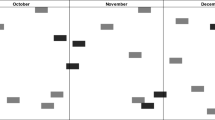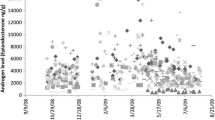Abstract
Copulatory data derived from observations of social groups of rhesus and stumptail macaques were analyzed to test the hypothesis that pairs of animals would resume copulation significantly sooner if a second male copulated with the female shortly after the first male’s ejaculation. Data from both groups supported the hypothesis. These results, extending previous studies in Macaca nemestrina,suggest that the shortening of copulatory intervals by social stimuli occurs in several species, both in social groups and in experimentally created triads. These findings also are consistent with the hypothesis that socially mediated resumption of mating is related to intrasexual competition among males.
Similar content being viewed by others
References
Adler, N. T. (1969). Effects of the male’s copulatory behavior on successful pregnancy of the female rat.J. comp. physiol. Psychol. 69: 613–622.
Adler, N. T., and Zoloth, S. R. (1970). Copulatory behavior can inhibit pregnancy in female rats.Science 168: 1481–1483.
Altmann, J. (1974). Observational study of behaviour: Sampling methods.Behaviour 49:228–267
Bielert, C. F., and Goy, R. W. (1973). Sexual behavior of male rhesus: Effects of repeated ejaculation and partners’ cycle stage.Horm. Behav. 4: 109–122.
Busse, C. D., and Estep, D. Q. (1984). Sexual arousal in male pigtailed monkeys (Macaca nemestrina): Effects of serial matings by two males.J. comp. physiol. Psychol. 98:227–231.
Dewsbury, D. A. (1972). Patterns of copulatory behavior in male mammals.Q. Rev. Biol. 47:1–33.
Dewsbury, D. A. (1979). Copulatory behavior of deer mice (Peromyscus maniculatus). II. A study of some factors regulating the fine structure of behavior.J. comp. physiol. Psychol. 93: 161–177.
Dewsbury, D. A. (1981a). Effects of novelty on copulatory behavior: The Coolidge effect and related phenomena.Psychol. Bull. 89: 464–482.
Dewsbury, D. A. (1981b). On the function of the multiple-intromission, multiple-ejaculation copulatory patterns of rodents.Bull. Psychon. Soc. 18: 221–223.
Goldfoot, D. A., Slob, A. K., Scheffler, G., Robinson, J. A., Wiegand, S. J., and Cords, J. (1975). Multiple ejaculations during prolonged sexual tests and lack of resultant testosterone increases in male stumptail macaques (M. arctoides).Arch. sex. Behav. 4: 547–560.
Gordon, T. P. (1981). Reproductive behavior in the rhesus monkey: Social and endocrine variables.Am. Zool. 21: 185–195.
Gordon, T. P., and Bernstein, I. S. (1973). Seasonal variation in sexual behavior of an all-male rhesus troop.Am. J. phys. Anthrop. 38: 221–225.
Matthews, M., and Adler, N. T. (1977). Facilitative and inhibitory influences of reproductive behavior on sperm transport in rats.J. comp. physiol. Psychol. 91: 727–741.
McClintock, M. K. (1981). Simplicity from complexity: A naturalistic approach to behavior and neuroendocrine function. In Silverman, I. (ed.),Laboratory Life: New Directions for Methodology of Social and Behavior Science, 8, Josey-Bass, San Francisco.
McClintock, M. K., Anisko, J. J., and Adler, N. T. (1982). Group mating among Norway rats. II. The social dynamics of copulation: Competition, cooperation, and mate choice.Anim. Behav. 30: 410–425.
Michael, R. P., and Saayman, G. S. (1967). Individual differences in the sexual behavior of male rhesus monkeys (Macaca mulatto) under laboratory conditions.Anim. Behav. 15: 460–466.
Missakian, E. A., Del Rio, L. R., and Myers, R. E. (1969). Reproductive behavior of captive male rhesus monkeys (Macaca mulatto).Comm. Behav. Biol. 4: 231–235.
Niemeyer, C., and Chamove, A. S. (1983). Motivation of harassment of matings in stumptailed macaques.Behaviour 87: 298–323.
Roonwal, M. L., and Mohnot, S. M. (1977).Primates of South Asia: Ecology, Sociobiololgy and Behavior, Harvard University Press, Cambridge, Mass.
Sawrey, D. K., and Dewsbury, D. A. (1981). Effects of space on the copulatory behavior of deer mice (Peromyscus maniculatus).Bull. Psychon. Soc. 17: 249–251.
Silverberg, A., and Adler, N. (1974). Modulation of the copulatory sequence of the male rat by a schedule of reinforcement.Science 185: 374–376.
Thornhill, R., and Alcock, J. (1983).The Evolution of Insect Mating Systems, Harvard University Press, Cambridge, Mass.
Waage, J. K. (1979). Dual function of the damselfly penis: Sperm removal and transfer.Science 203: 916–918.
Walker, M. L., Wilson, M. E., and Gordon, T. P. (1984). Endocrine control of the seasonal occurrence of ovulation in rhesus monkeys housed outdoors.Endocrinology 114: 1074–1081.
Wallen, K. (1982). Influence of female hormonal state on rhesus sexual behavior varies with space for social interaction.Science 217: 375–377.
Wilson, J. R., Kuehn, R. E., and Beach, F. A. (1963). Modification in the sexual behavior of male rats produced by changing the stimulus female.J. comp. physiol. Psychol. 56: 636–644.
Author information
Authors and Affiliations
Rights and permissions
About this article
Cite this article
Estep, D.Q., Gordon, T.P., Wilson, M.E. et al. Social stimulation and the resumption of copulation in Rhesus (Macaca mulatto) and stumptail (Macaca arctoides) Macaques. Int J Primatol 7, 507–517 (1986). https://doi.org/10.1007/BF02693661
Received:
Revised:
Issue Date:
DOI: https://doi.org/10.1007/BF02693661




